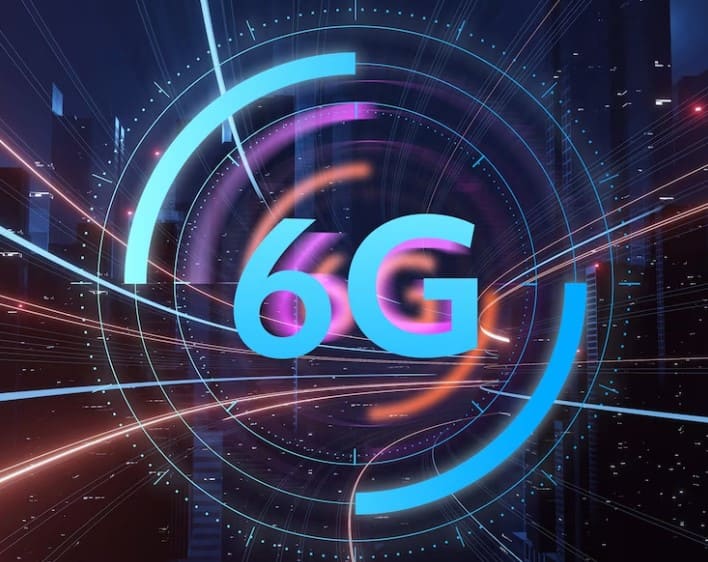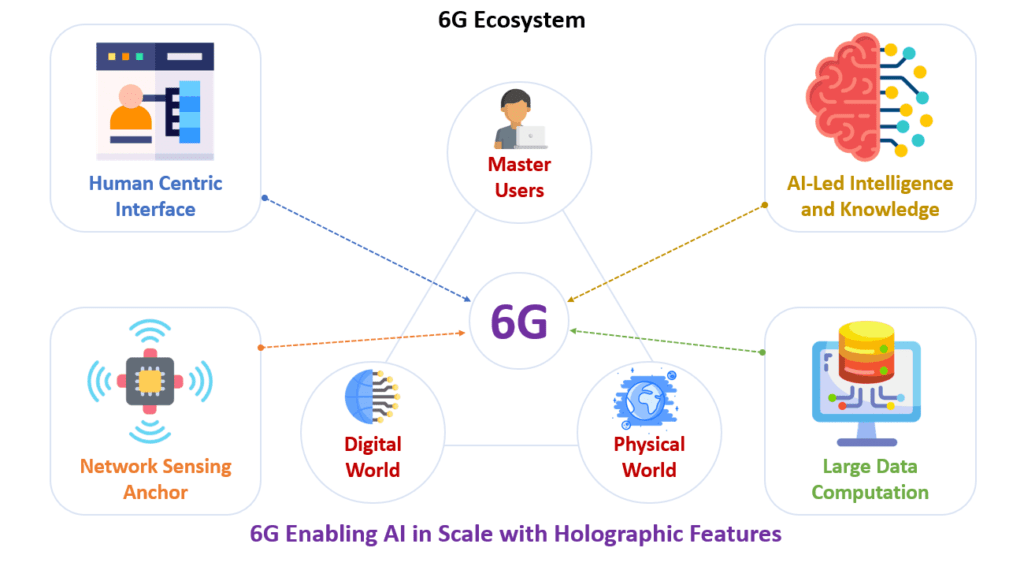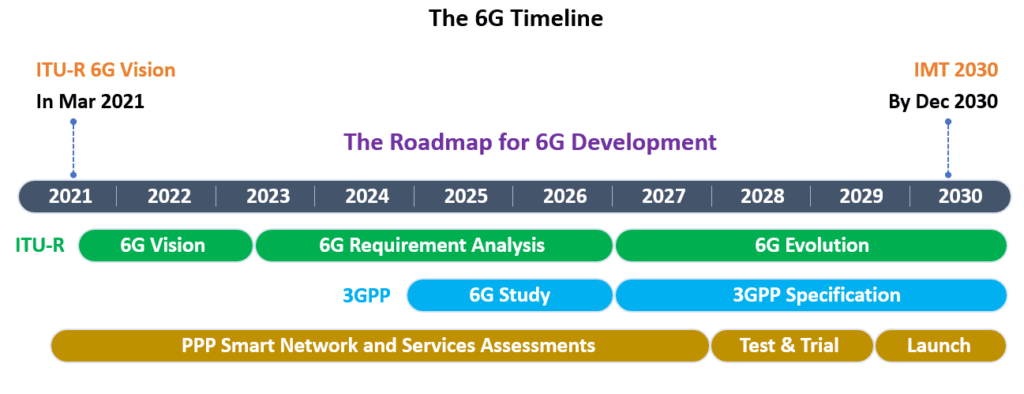
Overview:
Despite the ongoing global deployment of 5G networks, it’s remarkable that both developed and emerging economies are already setting their sights on the future: 6G. This next-generation wireless network is slated to become commercially available around 2030. In this context, we aim to provide you with a comprehensive understanding of 6G network technology. We will delve into the details of 6G, its distinctions from the current 5G standard, examine its fundamental components, explore the pivotal technologies propelling its development, scrutinize the evolving market landscape, highlight its significant advantages, and address the challenges it presents. Additionally, we will closely follow the noteworthy advancements in this field within the world’s leading economies.
Contents:
- What is 6G Network Technology
- How 6G Ecosystem Looks Like
- The 6G Timeline
- Why We Need 6G
- How 6G is Different from 5G
- The 6G Architecture Outlook
- Key Working Blocks of 6G
- Key Technologies that will Define 6G
- The 6G Market Landscape
- How 6G and Industry 5.0 are Related to Each Other
- Key Benefits 6G Offers in Wireless Networking
- Key Challenges to Overcome in 6G
- Major Developments Underway in the Top 5 Economies
What is 6G Network Technology:
6G, short for the 6th generation of mobile network technology, is currently in the midst of rigorous testing and development phases. Building upon the transformative impact of 5G on global data consumption trends, 6G promises to surpass these achievements by harnessing even higher frequencies than its predecessor. This leap in technology translates into significantly enhanced data throughput, facilitated by ultra-low latency connections, often achieving speeds of 1 microsecond or less. This exceptional capability positions 6G as a candidate to revolutionize instant global communications.
Furthermore, 6G is poised to usher in a new era of connectivity with its built-in Artificial Intelligence (AI) and Machine Learning (ML) capabilities. These features have the potential to empower next-generation Internet of Things (IoT) applications, opening doors to innovative and previously unimaginable possibilities.
While 6G represents the pinnacle of telecommunications technology, its implementation comes with notable challenges, particularly in terms of infrastructure cost and capital expenditure (CapEx). To navigate this terrain successfully, network operators may need to embrace flexible and decentralized business models. These strategies could include local spectrum licensing, spectrum and infrastructure sharing, the integration of edge computing, and the optimization of short-packet communication.
It’s worth noting that as of 2023, there is no universally accepted standard for 6G, whether governed by governmental or non-governmental bodies. The ongoing development of 6G technology underscores the dynamic nature of this field and the anticipation surrounding its eventual global deployment
How 6G Ecosystem Looks Like:

The 6G Timeline:

Why We Need 6G:
6G is poised to unlock a realm of transformative possibilities and help all of us in an effective way:
1. Offers Near-Instant and Unrestricted Connectivity: It aims to deliver seamless, near-instantaneous wireless connectivity, eliminating the barriers to swift data transmission and communication.
2. Provides AI and ML Integration Capabilities: 6G envisions a self-contained ecosystem of Artificial Intelligence (AI) and Machine Learning (ML), simplifying the integration of these technologies into various applications and devices.
3. Supports a Range of Comprehensive Functionalities: This next-generation network seeks to revolutionize connectivity by seamlessly managing control functions, enabling programmability, integrating sensing capabilities, enhancing communication, reducing energy consumption, ensuring infrastructure trustworthiness, scaling effortlessly, and maintaining affordability.
4. Transforms the Experience of Industrial or Individual Users: With its capabilities, 6G is poised to reshape industries and redefine how end-users interact with technology, ushering in a new era of connectivity and engagement.
How 6G is Different from 5G:
| Particulars | 5G | 6G (Tentative) |
| Introduction | 2016 | 2030 |
| Deployment | 2019 | 2031 |
| Concept | Wireless | Wireless |
| Latency | 1 to 10 milliseconds | Up to 0.1 millisecond |
| Connectivity Density | 1 Lakh Gadgets per Square Km | 100 Lakh Gadgets per Square Km |
| Power Efficiency | 100 times 4G | 100 times 5G |
| Spectral Efficiency | 100 times 4G | 100 times 5G |
| Standards | MIMO, Milli-meter Wave | Extreme MIMO |
| Access Mode | OFDM, BDMA, 5G NR Air Interface | Multiple OFDM |
| Encoding | Digital | Digital |
| Frequency | 1 GHz – 6 GHz | Tentatively 7 GHz – 20 GHz for higher capacity and 460 – 694 MHz for extreme coverage |
| Bandwidth | 30 GHz to 300 GHz | Up to 3 THz |
| Network Switching | Packet Switching | Noval Packet/ Optical Switching |
| Admission Control | Access Control | Execution Control |
| Data Rate (at Ideal Network State) | 200 Mbps To 20 Gbps | 1 to 10 Tbps (Tentative) |
| Network Core | Internet | Internet |
| Architecture Scope | Radio Access Network with Core Network (RAN + CN) | Terminal + RAN + CN |
| Cloud Native | Only Control Plane in 5G Core Network | E2E and cross-plane (User plane / Control plane / Management plane) in Core Network |
| Resource Type | Communication | Communication + Compute + Sensing |
| Service Type | Point-to-point Quality of Services | Point-to-multipoint transport, including configurable logical network overlay topologies with managed quality properties and net-app awareness, with compute services, sync services, AI service |
| Trustworthiness | Trustworthy Nodes | Trustworthy Adaptive Services/ Network of Networks |
| USP | Extremely High Throughput, Low Latency | Seamless Connected World at an Ultra-Low Latency |
| AI/ML Integration | Over the Top | Natively Integrated |
| Applications | HD Video Streaming, Remote Driving/ Medical Procedures | Holographic Collaborative World, Scaled AI Applications |
The 6G Architecture Outlook:
The 6G architecture is poised to exhibit remarkable flexibility and efficiency, designed to seamlessly facilitate the integration of a vast network of networks. This comprehensive framework will encompass nodes operating at frequencies exceeding 100 GHz, facilitating collaborative communication and sensing capabilities. It will harmoniously unite Non-Terrestrial Networks (NTNs) with terrestrial communication infrastructure, all underpinned by cutting-edge AI-powered enablers and local and distributed computing capabilities.
The incorporation of NTN elements, including Low Earth Orbit (LEO), Medium Earth Orbit (MEO), and Geosynchronous Orbit (GEO) satellites, as well as air and spaceborne entities, holds the promise of extending and complementing connectivity. This augmentation will not only expand coverage but also introduce distributed storage and compute services with an unwavering commitment to mission-critical reliability, availability, and resilience.
Key Working Blocks of 6G:
The next-generation 6G landscape is poised to rely on three fundamental working blocks for its operation:
1. Making Smart Use of Free Spectrum
A substantial portion of 6G research is centered around harnessing the potential of ultra-high frequencies, which have largely remained untapped but hold the promise of delivering exceptionally high data transfer speeds. The challenge lies in transmitting data across waves in the hundreds of gigahertz (GHz) or terahertz (THz) ranges, as these waves are incredibly small and delicate. Nevertheless, the tempting prospects of such high-frequency communication make it a pivotal component of 6G technology.
Furthermore, 6G aims to efficiently manage the available spectrum using sophisticated mechanisms, surpassing the limitations associated with traditional Frequency Division Duplex (FDD) or Time Division Duplex (TDD) approaches. This endeavor seeks to optimize the utilization of the spectrum and push the boundaries of what’s achievable in wireless communication.
2. Taking Full Advantage of Mesh Networking
While 5G predominantly relies on the hub-and-spoke architecture, the potential benefits of mesh networking in wireless communication have not been fully harnessed. The hub-and-spoke model, prevalent in 5G, involves mobile devices connecting first to anchor nodes (cell towers), which then relay data to a central backbone. However, this architecture can introduce network latency and inefficiencies.
6G is anticipated to revolutionize this landscape by embracing mesh networking. This approach empowers mobile devices to establish independent connections with multiple nodes through advanced amplification techniques. As a result, each device gains the capability to expand its coverage and range, offering a more efficient and resilient network infrastructure.
3. Integrating with the Next-gen Internet Protocol
6G is poised to potentially introduce a novel iteration of the Internet Protocol (IP) that surpasses the capabilities of both IPv4 and IPv6. This advanced IP variant is expected to deliver ultra-fast performance and introduce innovative features, including the prioritization of data traffic, akin to prioritizing courier packages for the efficient navigation of information within the network.
Key Technologies that will Define 6G:
1. Artificial Intelligence and Machine Learning
6G is renowned for its intelligence, driven by the integration of an array of Artificial Intelligence and Machine Learning techniques, including Deep Learning. These techniques are anticipated to be deployed throughout the network and across multiple layers and functions. From enhancing beamforming optimization within the radio layer to refining scheduling processes at cell sites through self-optimizing networks, AI/ML will play a pivotal role in achieving superior performance with reduced complexity.
2. Redefined Spectrum Bands
Each new wireless network generation necessitates the allocation of pioneering spectrum resources to fully harness the potential of emerging technologies. In the case of 6G, this entails a two-fold approach: repurposing existing mobile communication spectrum from legacy technologies to the new generation, and identifying new frequency bands to optimize the utilization of 6G networks.
Notably, 6G’s ambition extends to pushing the boundaries of localization capabilities by leveraging a broad spectrum, including novel spectral ranges extending into the terahertz domain, as it strives to redefine the localization experience.
3. Sensible Network Having Sense at Its Core
6G, enhanced by the integration of AI/ML and bolstered by edge computing capabilities, possesses the remarkable ability to comprehensively sense its environment, including individuals and objects within it. Consequently, it has the potential to furnish valuable situational information, encompassing the collection of data from signals interacting with objects. This information can extend to discerning object type, shape, relative position, velocity, and potentially even material properties.
In essence, 6G has the capacity to amplify a user’s sensory experience, extending it to every point of contact within the network. In doing so, it instils the entire network with a heightened level of cognitive awareness and responsiveness.
4. Extreme Connectivity and Reliability
6G demands exceptional levels of connectivity, with stringent sub-millisecond latency requirements. Building upon the foundation of Ultra-Reliable Low-Latency Communication (URLLC) services introduced in 5G, 6G is poised to elevate and fine-tune these capabilities to meet the exacting demands of extreme connectivity scenarios. This enhancement in connectivity and reliability holds the potential to revolutionize real-time experiences, enabling seamless, immersive encounters such as real-time holographic experiences and the dynamic updating of digital twin models.
5. Advanced Network Architectures
While 5G marked a pivotal shift by being the first wireless network designed for enterprise and industrial use, effectively replacing wired connectivity, 6G is poised to usher in a new era of even more intricate industrial applications. In response to these heightened complexities, enterprises will necessitate advanced network architectures capable of offering enhanced flexibility and specialization to accommodate the evolving demands of the industrial landscape.
6. Security and Trust at Center
Anticipating the need for robust security, 6G is envisioned to be meticulously designed to guard against threats such as jamming. Additionally, the widespread adoption of mixed reality for virtual collaboration will underscore the importance of privacy preservation. Both security measures and privacy safeguards are poised to play pivotal roles in ensuring the secure and safe execution of 6G networks.
7. Edge and Nano-core Coordination
The concept of a nano-core is projected to become a central computing core that amalgamates elements of High-Performance Computing and Artificial Intelligence. This nano-core is anticipated to serve as a shared computational resource for networks and systems alike. With 6G networks poised to generate significantly larger volumes of data compared to their 5G counterparts, computing paradigms will evolve to facilitate seamless coordination between edge and core platforms, ensuring efficient processing and management of this burgeoning data landscape.
The 6G Market Landscape:
Market Size
According to a report, The global 6G market is projected to witness remarkable growth, with an estimated value exceeding USD 159.5 Billion by 2035. This growth is anticipated to be driven by a compounded annual growth rate (CAGR) of 127.2% from 2031 to 2035, taking into account the commercial availability of 6G to the general public, commencing in 2031. Furthermore, the predevelopment phase of 6G is expected to yield a market size of USD 7.5 Billion by 2030, signifying the substantial anticipation and investment in this emerging technology.
Regional Market Behavior
The North American market is poised to dominate a significant share of the 6G market during this period. Telecom giants such as AT&T and Ericsson are already at the forefront of 6G development efforts, positioning North America as a key leader in the advancement of 6G networks.
Furthermore, the Asia Pacific region is expected to secure a substantial portion of the 6G market share. This is attributed to the region’s growing emphasis on satellite communication and technological advancements. Notably, China has taken a pioneering role by launching the world’s most significant 6G test satellite into space in the late 2020, underscoring its prominence in the global 6G landscape. Similarly, India has announced plans to introduce 6G technology by 2024, further highlighting the region’s commitment to the development and adoption of 6G.
Potential Driving Forces
The 6G market is poised for significant expansion, driven by escalating demand for low-latency networks across various industries. As automation continues to proliferate, industries increasingly rely on intricate applications that necessitate rapid and dependable network connectivity. Moreover, the proliferation of pivotal next-generation technologies like the Internet of Things (IoT) and blockchain underscores the need for high-speed wireless network capabilities, a realm where 6G excels.
Furthermore, the influx of smart city initiatives, the expanding user base of the internet, and the proliferation of edge computing devices are expected to act as catalysts, propelling the 6G market forward from 2031 to 2035. These factors collectively fuel the growth trajectory of 6G, positioning it as a vital enabler of the next-generation digital landscape.
Key Use Cases
While the advent of 6G may not necessarily introduce a plethora of entirely new use cases, it is poised to significantly enhance and optimize existing 5G use cases. For example, applications like telemedicine, autonomous driving, and virtual or augmented reality collaboration will experience even smoother operation and greater efficiency within a 6G framework.
Moreover, the integration of non-terrestrial networks (NTNs) into 6G introduces a transformative dimension. Devices will gain the ability to independently establish connections with satellites, tailoring their communication based on specific needs and requirements. This capability opens up the potential for last-mile connectivity in previously untouched areas. Additionally, it holds promise for various scenarios such as crisis management, maritime communication, and disaster response, further underlining the versatility and impact of 6G technology.
How 6G and Industry 5.0 are Related to Each Other:
5G marked a significant milestone as the first wireless network purposefully designed to meet the demands of industrial applications, effectively supplanting traditional wired broadband connections and ushering in the era of wireless connectivity. This transition catalyzed the fourth industrial revolution, commonly referred to as Industry 4.0, owing to its seamless integration with cutting-edge technologies such as the Internet of Things (IoT), Artificial Intelligence (AI), Machine Learning (ML), and Edge Computing.
The impending arrival of 6G is expected to take this industrial transformation a step further, giving rise to what could be called the fifth industrial revolution, often referred to as Industry 5.0. Leveraging its inherent sensing capabilities, 6G is poised to supercharge industrial applications by enabling collaborative communication and advanced localization, thereby revolutionizing the way industries operate and opening new frontiers in connectivity.
Key Benefits 6G Offers in Wireless Networking:
As 6G networks continue to evolve with increasing complexity and new developments, they are expected to bring forth a wide array of benefits, including:
1. Protection from Cyber Criminals
6G networks are poised to offer robust defenses against intentional interfering signals, bolstering their resilience to external disruptions. Additionally, these networks prioritize network privacy, safeguarding users’ sensitive personal information and data.
2. Personalization with Real-time Quality Experience
6G is set to harness the capabilities of an AI-powered Radio Access Network (RAN), enabling mobile network users to enjoy a personalized 360-degree network experience in real-time. The real-time user data collected may be instrumental in tailoring and optimizing the quality of service, further enhancing the overall user experience.
3. Favored Extension in Application Utility
The remarkable increase in data throughput provided by 6G is poised to revolutionize the capabilities of various applications in novel and inventive ways. An illustrative example of this transformation is the capacity to efficiently accommodate and serve a diverse range of end-users simultaneously on a single application, facilitated by the utilization of orthogonal frequency-division multiple access (OFDMA).
4. Innovation Support Across Tech Infrastructure
6G, the latest in wireless technology, brings with it the need for several supporting technologies. One such development is the creation of highly advanced data centers. This is because 6G will generate an immense amount of data, and processing it in real-time efficiently is crucial. To do this, there must be seamless coordination between different parts of the network, which will result in the enhancement of data centers to meet these demands.
5. Cost Savings through Reduced Infrastructure Dependency
6G is expected to employ virtualization in a manner that eliminates the necessity for specialized infrastructure hardware and software. For instance, components like media access control (MAC) and physical (PHY) layers, which currently rely on dedicated network hardware and software, will undergo full virtualization in 6G. This transition will effectively reduce the additional costs associated with network systems.
6. Optimized Network Penetration and Coverage
Localization is a fundamental principle of 6G, with the goal of achieving precise positioning. Unlike previous networks like 5G, which primarily focused on providing outdoor coverage, 6G is set to break this barrier by ensuring comprehensive indoor coverage. This will be accomplished through the deployment of femtocells (small cell sites) and Distributed Antenna Systems (DASs), enabling seamless connectivity even within indoor spaces.
Key Challenges to Overcome in 6G:
The exploration of 6G networks is still in its nascent stages, and as such, numerous challenges and complexities lie ahead. With a multitude of potential approaches and applications, 6G networks are envisioned to be highly intelligent and adaptable by overcoming some of the key challenges:
1. Adapting to the Tera-Hz Communication
6G is set to leverage Tera-Hz bandwidth for its network, a move that promises to substantially enhance system capacity by expanding the available spectrum. However, it’s important to note that these high-frequency ranges, while offering increased capacity, come with challenges. They are susceptible to obstructions and experience significant absorption losses, making them more suitable for short-range transmission. Consequently, the successful implementation of 6G at these frequencies will demand the deployment of small-sized transceivers characterized by low noise levels and minimal inter-module interference, all of which must be deployed in large numbers to support high-frequency devices effectively.
2. Designing Flexible Systems and Dynamic Protocols
Existing channel estimate models may struggle to adapt to the variability and uncertainty associated with 6G frequencies. Consequently, there is a pressing need for the development of novel channel and propagation models characterized by flexible designs and dynamic protocols. These advanced models will be essential for effectively managing the complex and dynamic 6G environments, ensuring seamless connectivity, and facilitating network interoperability.
3. Building Interconnected and Interoperated Communication Systems
6G envisions a network ecosystem where different types of networks, including terrestrial and satellite networks, are interconnected to provide extensive coverage and support high mobility. However, implementing seamless communication between satellites and ground-based systems presents challenges. Factors like Doppler shift and inter-satellite links can complicate the integration of satellite communication with ground communication. These challenges may impact interoperability by introducing synchronization issues, random access challenges, and signal recognition complexities.
4. Managing Edges with New AI Models
6G will heavily depend on edge computing to enhance node intelligence and the network’s computational capacity. Nonetheless, the constraints of limited edge storage and computational power may hinder the implementation of complex AI-based systems at the edge. To address this challenge, it is imperative to develop more sophisticated AI algorithms specifically tailored for edge nodes. Additionally, the development of efficient mobile edge scheduling and offloading mechanisms is crucial to enhance the overall system’s efficiency.
5. Managing Power and Energy Efficiency
As an intelligent network system, 6G is expected to heavily leverage AI, resulting in a substantial demand for robust computational power and extensive data processing capabilities across the network. Consequently, there is a pressing need for effective power management and energy efficiency strategies to ensure the smooth operation of the system while maintaining sustainability.
6. Securing the Network and Maintaining the Privacy
Given that a 6G network will continuously collect and transmit vast amounts of data, the establishment of a robust security strategy and encryption system is paramount to ensure data integrity and prevent breaches. Additionally, 6G networks are expected to provide safeguards against emerging and unknown threats. Consequently, the network’s design must prioritize trustworthiness while upholding the principles of privacy and confidentiality.
Major Developments Underway in the Top 5 Economies:
United States:
In 2020, the Alliance for Telecommunications Industry Solutions (ATIS) encouraged the United States administration to convene telecommunications industry leaders and take the initiative in 6G research. By 2022, the Federal Communications Commission (FCC) had granted the first Spectrum Horizons License, allowing experimentation with frequencies ranging from 95 GHz to 3 THz.
The United States has also set its sights on two draft bills aimed at allocating a budget for a task force dedicated to exploring the design and deployment of 6G technologies. Furthermore, the U.S. has entered into a Memorandum of Understanding (MoU) with Japan, pledging a joint investment of USD 4.5 Billion for 6G development. As of early 2023, the U.S. has initiated plans for the eventual rollout of 6G networks nationwide.
China:
The commercial launch of 6G in China is anticipated to commence in 2030. China has made significant strides in 6G development, claiming the achievement of the first real-time wireless data transmission at terahertz frequencies in 2023, with a remarkable wireless transmission speed of 100 Gigabits per second. Furthermore, in late 2020, China successfully launched its inaugural 6G satellite into space.
Leading Chinese telecom company, China Unicom, has set ambitious goals to complete technical research and explore early application scenarios for 6G technology by 2025. In the first half of 2023, the company introduced a 6G public experimental verification platform, offering an open and scenario-based joint R&D testing environment for industrial partners.
Meanwhile, Huawei, the prominent Chinese multinational technology firm, is actively pursuing the development of its own 6G technology and has announced plans to launch ultra-fast networks by 2030.
Japan:
In late 2022, Japan allocated a substantial fund of USD 450 Million dedicated to the development of next-generation 6G wireless networks. The country has set an ambitious goal to launch 6G services domestically by the year 2030.
In mid-2022, key players in the Japanese telecommunications industry, including NTT DOCOMO and Nippon Telegraph and Telephone Corporation (NTT), joined forces with mobile technology vendors such as Fujitsu, NEC, and Nokia. Together, they embarked on experimental trials to explore new mobile communications technologies, with the objective of commercially deploying 6G services by around 2030.
Furthermore, in 2021, both Japan and Finland initiated collaboration on the advancement of 6G technologies. This collaboration was channeled through Japan’s ‘Beyond 5G Promotion Consortium,’ which is dedicated to the commercialization of 6G technology, with a target timeframe in the 2030s.
Germany:
In late 2022, Deutsche Telekom initiated the ‘6G NeXt’ project, a collaborative effort involving nine partners dedicated to the development of integrated systems and sub-technologies for 6G. The project has received funding from the German government.
In 2021, the German government made a significant commitment by allocating EUR 700 Million for 6G research and development over the subsequent five years. An initial investment of EUR 200 Million was earmarked to establish an innovation ecosystem focused on future communication technologies centered around 6G.
Additionally, Germany launched the ‘6G Platform Germany’ program, which is geared towards advancing Future Communication Technologies and 6G. This program serves as an overarching entity for the German 6G initiative, facilitating collaboration, networking, and coordination within the program. It also acts as a point of contact for external collaborations on both European and international levels.
India:
India has set an ambitious target to roll out high-speed 6G communication services by 2030. To achieve this goal, India has established the Bharat 6G Alliance, a collaboration comprising industry leaders and academia. The alliance is dedicated to driving innovation in 6G projects, identifying and funding research initiatives, and deploying next-generation technologies within the country. Additionally, the Bharat 6G Alliance, along with Indian 6G patents, aims to develop 5G advanced/6G products and solutions, support India’s participation in 3GPP standards, and facilitate market access for startups.
India is also committed to achieving a significant presence in the 6G landscape and aims to possess 10% of the world’s 6G patents by 2030. As of the first half of 2023, India has already acquired over 200 6G technology patents, with this number continuing to grow. This strategic move positions India prominently on the global 6G map.
Furthermore, India has approved INR 240.5 Crore (~USD 30 Million) from the Telecom Technology Development Fund for two 6G projects. The first project involves the creation of a 6G THz testbed with orbital angular momentum, while the second focuses on multiplexing and advanced optical communication testbeds, involving a consortium of academia and industry.
Under the Digital Communication Innovation Square initiative, India is also offering grants of INR 48 Crore (~USD 6 Million) to support 66 startups and MSMEs in the development of innovative solutions.
In November 2021, the Department of Telecommunications in India established the Innovation Development Group for 6G (TIG-6G), comprising members from various government departments, research institutions, academia, standardization bodies, telecommunications service providers, and industry stakeholders. TIG-6G is tasked with defining a vision, mission, and objectives for 6G, as well as formulating a roadmap and action plans for its success.











